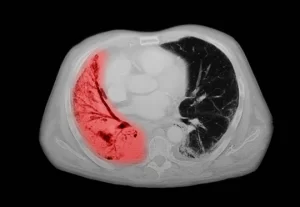Lung cells entering an aged, non-proliferating state (senescence) can trigger disease, which researchers can prevent with nicotinamide mononucleotide (NMN) in mice.
Highlights
· Supplementing aged mice with NMN protects lung cells from entering a stress and age-induced state called senescence that can facilitate lung disease.
· NMN treatment reduces lung structural damage following exposure to a lung scarring agent.
· The study provides the first evidence that NMN may prevent and protect against lung cell aging that can lead to disease.

When age gets the best of our lungs and induces pulmonary disease, lung cells responsible for oxygen exchange to the blood called alveolar epithelial cells (AECs) lose their function and drop in numbers. How the function and quantity of these cells diminish with aging is not fully understood, but scientists think it has something to do with their entry into a non-proliferating state called senescence.
Wei and colleagues from the National Clinical Research Center for Geriatrics in China published a study in MedComm showing for the first time that the molecule NMN reduces cell senescence to promote lung health in aged mice. By giving mice 500 mg/kg/day of NMN through drinking water, they found that NMN reduces levels of age-related proteins in mouse lungs and alleviates chemically-induced and senescence-associated lung damage.
“Dietary supplementation of NMN might be a new and effective way to prevent and reduce aging-related lung diseases and stress-induced lung injury in the future,” proposed Wei and colleagues.
Falling Lung NAD+ Levels During Aging
NMN is a precursor to nicotinamide adenine dinucleotide (NAD+) — a crucial molecule for metabolism and DNA health that shows reduced levels with age in many cell types and organs, including the lungs. Age-related diseases like cardiovascular ailments, neurodegenerative conditions, and metabolic impairments have all been linked to age-associated NAD+ level reductions, and research has shown that NMN alleviates various age-related diseases in mice. But whether it helps with lung aging and senescence hadn’t been explored, until now.
NMN Reduces the Buildup of Age-Associated Proteins
To figure out whether NMN prevents lung tissue aging and AEC senescence, Wei and colleagues examined its effects on levels of the two proteins p16 and p21 that are linked with aging in mice. The p16 protein slows cell divisions and proliferation during the progression of senescence, and the research team found that NMN diminished its levels in mouse lungs. The same was true for NMN’s effects on levels of p21, a protein that links DNA damage accumulation to cell proliferation cessation during senescence. The drop in the lung’s levels of p16 and p21 suggests that NMN alleviates lung tissue senescence and protects it during aging.
NMN Prevents Lung Cells From Entering Senescence
To further investigate whether NMN directly protects against AEC senescence, Wei and colleagues looked at the effect of the NAD+ precursor on AECs that had been induced into senescence in two different ways. NMN treatment substantially reduced the number of lung cells that entered replicative senescence — a state in which cells can no longer proliferate after undergoing too many divisions — when cultured in laboratory dishes. Wei and colleagues also stressed the lung cells by treating them with an antibiotic called bleomycin, known to induce lung cell senescence. They found that NMN treatment significantly reduced the number of senescent cells following the bleomycin antibiotic stress. These findings show that NMN protects against senescence induced both by excessive replication and stress.
NMN Protects Lung Structure and Function Under Stress
To test the effects of NMN on overall lung structure, Wei and colleagues treated mice with bleomycin by making them cough and then inhaling the antibiotic, which caused lung tissue destruction. When these mice were treated with NMN, they found reduced lung tissue destruction. The research team also found reduced numbers of inflammatory cells in the lungs and diminished overall lung weight of bleomycin-treated mice that were given NMN. Since treating mice with bleomycin induces lung scarring and the accumulation of lung scar tissue facilitates heavier lung weight, these results indicate that NMN treatment prevents senescence-associated lung scarring. These results provide further evidence that NMN significantly improves AEC senescence in aged mice.
NMN May Provide Protection Against Age-Related Lung Disease
“Our data suggested that NMN could effectively alleviate the replicative and stress-induced senescence of [alveolar epithelial cells],” said Wei and colleagues. By showing that boosting NAD+ levels with NMN prevents age-associated lung cell senescence, the findings suggest that reduced NAD+ levels may play a role in senescence.
Moreover, NMN could ameliorate cell senescence related to diminished NAD+ levels. “It provides a preventive and therapeutic approach for aging-related chronic lung diseases and lung injury caused by external stimuli.” Wei and colleagues go on to say that NMN’s dietary supplementation may be a new, effective means to prevent and reduce age-related lung diseases and stress-induced lung injury in the future.
Full Text Sources
